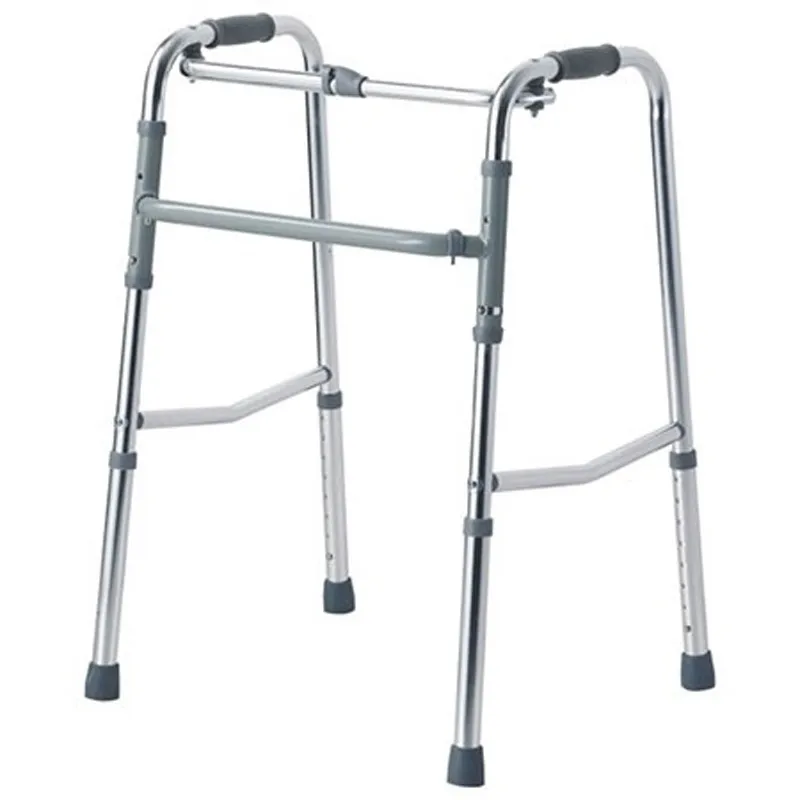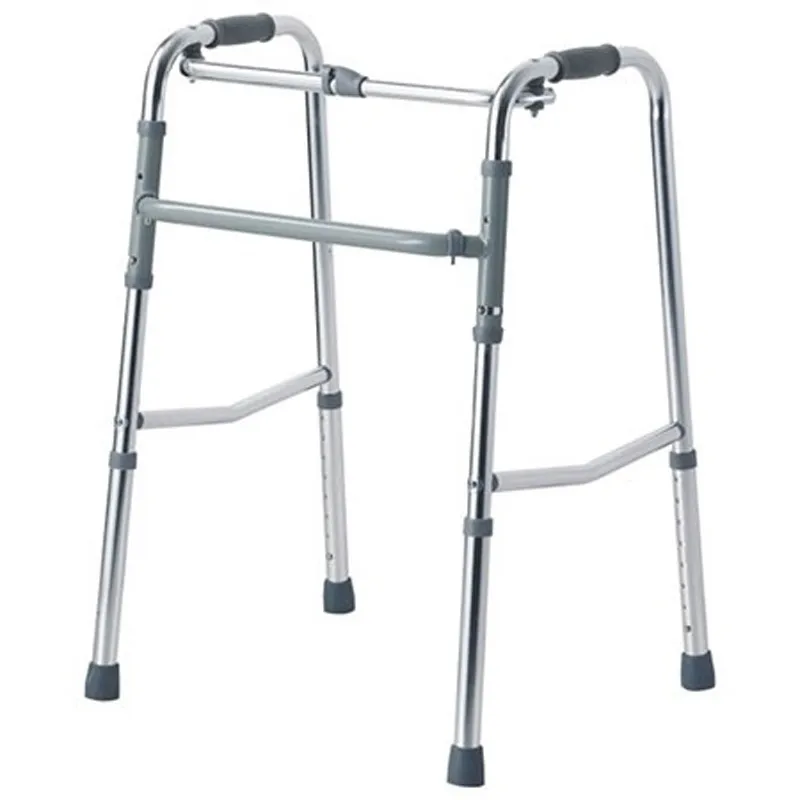
Wheelless Walking Frame

4-Wheeled Rollator
For people with limited mobility, decreased muscle strength, or impaired balance, a suitable walking aid can not only improve mobility but also enhance independence and safety.
Among various assistive devices, wheelless walking frames and 4-wheeled rollators are two of the most common. However, many patients, family members, and even non-professional medical professionals often confuse the two and make the wrong choice, leading to usage difficulties, potential risks, and delayed recovery.
So, what are the differences between wheelless walking frames and 4-wheeled rollators? Who are they suitable for? And how can you choose wisely?
This article will professionally explain the differences between these two devices from multiple perspectives, including structural design, feature comparison, applicable population, usage environment, safety, and price, to help readers make the most appropriate choice of walking aid.
What is a wheelless walking frame?
A wheelless walking frame is an assistive device that helps people with limited mobility or physical weakness walk. Typically made of lightweight metal, it resembles a four-legged frame. Users hold onto the handlebars with both hands, supporting their body weight for balance and stability, helping them walk more safely and confidently.
Features of a wheelless walking frame:
• It lacks wheels, and the four legs are typically equipped with anti-slip pads to increase traction and prevent slipping.
• Its simple structure and excellent stability make it suitable for those who require stronger support.
• It is suitable for those in rehabilitation, the elderly, or those with limited mobility, helping to reduce the burden on their lower limbs.
Compared to wheeled walkers (which have sliding wheels for easier movement), wheelless walking frames are more suitable for those in the initial stages of rehabilitation or those who require stronger support.
(Reciprocable Folding Aluminium wheelless Walking Frame)
What is a 4-wheeled rollator?
A 4-wheeled rollator is a walker with four wheels, typically used to help people with unsteady walking or reduced physical strength maintain balance and safety while walking. Unlike a regular walker, which requires lifting and moving, a 4-wheeled rollator is pushed, saving effort and allowing for smoother movement.
Key Features of a 4-wheeled rollator:
• Four wheels: Typically, two wheels are located at the front and two at the back, making it easy to push and turn, reducing the burden on the user.
• Braking system: Equipped with a handle brake, the user can control speed and ensure safety.
• Seat design: Many 4-wheeled rollators feature a folding seat in the middle for the user to rest.
• Basket or storage bag: Convenient for carrying items, increasing the convenience of daily use.
• Height adjustment: The handle height is usually adjustable to accommodate people of different heights.
Overall, a 4-wheeled rollator combines support and convenience, making it a very practical daily walking aid.
(Deluxe Comfort Larger 4 Wheels Aluminum Walker Rollator)
Wheelless walking frame vs. 4-wheeled rollator: Comparative analysis
The following table compares wheelless walking frames and 4-wheeled rollators in several key aspects:
Comparison Dimensions | Wheelless walking frame | 4-wheeled rollator |
| Structure | Metal frame, no wheels, fixed legs | Four wheels with brakes and a seat/basket |
Mobility | Lift-down-forward | Push-to-roll |
| Usage Scenarios | Indoors, on flat ground | Outdoors, parks, shopping malls, hospitals |
| Stability | Very high, almost no sliding | Higher, depending on brakes and usage habits |
| Stamina Required | High, requires upper limb strength | Lower, suitable for frail individuals |
| Sitting Capacity | No | Yes |
| Foldable | Partially foldable | Most are foldable for easy portability |
| Target Audience | For patients with poor balance, frailty, or early recovery | For those with moderate mobility and outdoor activities |
| Price Range | Low | Higher, depending on configuration |
Who is a wheelless walking frame more suitable for?
Wheelless walking frames are suitable for the following groups:
• Patients in the early stages of postoperative recovery: For example, those after knee replacement or hip surgery may have reduced weight-bearing capacity in their lower limbs and require stable support.
• Elderly people with poor balance: They are at high risk of falling and require higher static support.
• Parkinson's disease or post-stroke patients: Static support devices are more suitable for those who have difficulty walking and cannot coordinate to move a rollator.
• Early rehabilitation training: For example, physical therapy training for standing and walking stability.
Wheelless walking frames are not suitable for:
• Those with upper limb weakness who cannot lift a walker;
• Those who cannot coordinate their steps.

Who is a 4-wheeled rollator suitable for?
A 4-wheeled rollator is suitable for the following groups:
• Those who need to walk for long periods or engage in outdoor activities: For example, elderly people going shopping, walking, or traveling.
• Those with moderate lower limb strength who require light support: For example, those with mild balance impairments or low back pain.
• Elderly people with weak physical strength but normal cognition: Pushing a rollator is more energy-efficient than lifting a walker.
• Those who need intermittent rest: The built-in seat allows for rest at any time to prevent fatigue.
4-wheeled rollators are not suitable for the following groups:
• People with severe cognitive impairment (unable to operate the brakes);
• Those with severe lower limb weakness who cannot stand;
• Living in a confined environment (wide bodies make turning difficult);
Safety Comparison: Hidden Risks You May Not Be Aware of
Risks of wheelless walking frames:
• Unstable during lifting, which can cause the body to tilt;
• Can easily get stuck on slippery, uneven surfaces;
• Frequent lifting can cause wrist and shoulder fatigue and even injury.
Risks of 4-wheeled rollators:
• Sitting without locking the brakes can cause slipping;
• Poor control when descending a slope can lead to "running away";
• Can easily collide with furniture in confined spaces.
Reminder: Regardless of the type of rollator used, a doctor or rehabilitation therapist should conduct a pre-use evaluation and training.
Wheelless walking frame vs. 4-wheeled rollator: Price comparison
Item | ||
| Average Price | $60–200 | $120–$1,000 |
| Durability | Simple construction, long lifespan | Multiple components, requires regular maintenance |
| Maintenance | Almost maintenance-free | Needs to check brakes, wheel wear, etc. |
| Foldable Portability | Common | High |

Dayang Medical recommends: How to choose the right mobility device for you?
1. Equipment selection should vary depending on the stage of recovery
• Early postoperative stage → Wheelless walking frame → Late postoperative stage/well-recovered → Four-wheeled rollator or cane.
2. Environmental factors are crucial
• Small home → Choose a narrow, foldable device.
• Need to walk outdoors → Choose a four-wheeled rollator with good brakes and a seat.
3. Cognitive assessment is essential
• Understanding the operating procedures and determining when to apply the brakes are key to ensuring safety.
4. Match the height and width of the device to your height and weight
• When purchasing, confirm that the device is height-adjustable and has a weight capacity that matches the user's weight.
Are your prices competitive compared to other suppliers?
As a direct factory, we eliminate middlemen and pass the savings to our customers. Our products are priced to support bulk buyers, healthcare resellers, and procurement teams seeking value. You’ll find our prices to be competitive, with low MOQ, volume discounts, and seasonal promotions available on selected items such as electric wheelchairs or rollator walkers.










